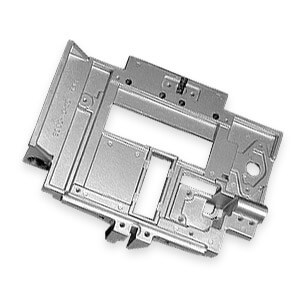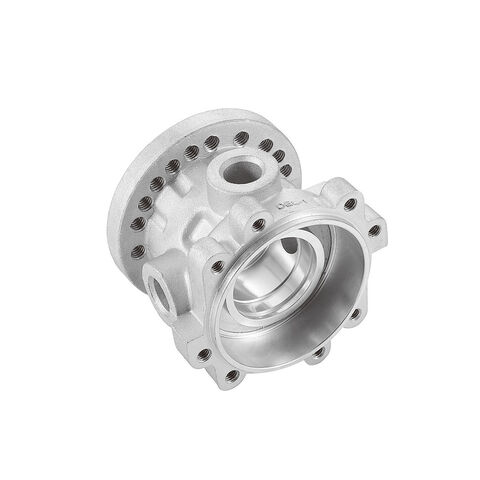The growth of aluminum casting and its modern-day applications
Wiki Article
The Evolution of Light Weight Aluminum Spreading Techniques
Over the decades, different innovative techniques have actually changed aluminum casting, substantially enhancing its efficiency and accuracy. The advancement began with standard sand spreading methods, which, while effective, usually resulted in variances in surface area coating and dimensional accuracy. The introduction of die casting in the mid-20th century enabled faster production rates and boosted quality, as molten aluminum was required right into mold and mildews under high stress, reducing porosity and enhancing information.Additional improvements consisted of financial investment spreading, which gave even elaborate styles and finer tolerances. The development of computer system mathematical control (CNC) innovation likewise reinvented mold and mildew style, allowing makers to produce intricate geometries with impressive precision. Today, additive production strategies, such as 3D printing for developing mold and mildews, get on the increase, enabling quick prototyping and minimized preparations. Generally, these improvements have actually considerably affected the aluminum casting process, accommodating a broader array of commercial applications.
Advantages of Aluminum in Production
Light weight aluminum has actually ended up being a favored material in manufacturing due to its distinct combination of residential or commercial properties that enhance performance and efficiency across numerous applications. Its light-weight nature permits lowered power intake throughout transportation and assembly, making it an affordable choice for many sectors. Additionally, light weight aluminum shows superb deterioration resistance, making certain long life and lowering maintenance costs.ght ratio allows the production of strong yet lightweight components, which is particularly advantageous in sectors such as auto and aerospace. Light weight aluminum likewise offers excellent thermal and electric conductivity, making it ideal for a selection of commercial applications, including electronic devices and warm exchangers.
Aluminum's pliability permits for intricate styles and simple manufacture, facilitating the production of complicated forms without endangering architectural integrity. These advantages jointly add to light weight aluminum's growing prominence in contemporary production procedures, driving technology and improving product performance throughout a large array of sectors
Developments in Aluminum Casting Innovation
As improvements in producing innovation remain to progress, technologies in light weight aluminum spreading have actually arised, improving effectiveness and precision in manufacturing processes. Among these developments is the introduction of advanced simulation software, which allows manufacturers to design the spreading procedure essentially. This innovation allows the prediction of potential problems and optimizes mold design, inevitably lowering product waste. Furthermore, the advancement of new alloys has increased the array of applications for light weight aluminum castings, improving mechanical buildings and rust resistance.Additionally, the adoption of 3D printing for mold and mildew manufacturing has revolutionized the spreading process, enabling the production of complicated geometries that were previously unattainable. This change not only reduces lead times yet likewise facilitates personalization in manufacturing. Overall, these advancements contribute substantially to the high quality and versatility of aluminum spreadings, positioning them as an essential element in the future of manufacturing innovation.
Influence On Manufacturing Efficiency and Expense Decrease
While the development of light weight aluminum casting modern technologies introduces countless benefits, its most significant impact depends on improving production effectiveness and driving cost decrease. By improving the spreading process, suppliers can produce complicated parts with higher rate and precision, significantly decreasing waste. Developments such as high-pressure die spreading and advanced mold and mildew layouts permit quicker cycle times and enhanced dimensional precision, which reduce rework and scrap prices.The light-weight nature of aluminum adds to lower transport costs and power consumption throughout manufacturing. Therefore, producers can accomplish substantial economies of range, eventually reducing the per-unit expense of products. The capacity to create premium castings in larger amounts also enables firms to react more promptly to market demands - aluminum casting. These performance gains and cost savings setting aluminum casting as an affordable benefit in the manufacturing landscape, cultivating further financial investments in modern technology and ability growth
Applications of Aluminum Casting Across Industries
The flexibility of aluminum casting has actually caused its extensive fostering across various industries, taking advantage of the benefits of light-weight, durable elements. In the auto field, light weight aluminum spreadings are utilized for engine blocks, transmission real estates, and wheels, adding to sustain performance and performance. The aerospace market utilizes light weight aluminum spreadings for architectural elements, where weight reduction is essential for flight effectiveness. On top of that, the customer electronic devices market leverages light weight aluminum spreading for tool housings and parts, improving resilience while keeping a smooth style. The construction industry also benefits from light weight aluminum spreadings, utilizing them in window frames and architectural elements that require both stamina and visual appeal. The medical field employs light weight aluminum spreadings for devices and devices, where precision and reliability are critical. On the whole, the diverse applications of aluminum casting throughout these industries show its integral duty in progressing modern manufacturing techniques.
The Future of Aluminum Casting in Manufacturing
Advancement in aluminum spreading technology assures to improve making processes in the coming years. Advancements such as 3D printing and computer-aided design are enhancing production, permitting for a lot more complex geometries and decreased waste. The combination of automation and robotics boosts performance, making it possible for manufacturers to generate top quality parts with minimal human treatment. Additionally, the development of new light weight aluminum alloys increases toughness and durability, increasing the prospective applications in sectors like aerospace and automobile.As sustainability comes to be a concern, reusing abilities within aluminum spreading will improve, decreasing environmental influence. The execution of wise manufacturing techniques, consisting of IoT and data analytics, will certainly further enhance production workflows and upkeep techniques. These improvements not only boost operational performance but also reduced prices, making light weight aluminum casting a much more appealing alternative for manufacturers. Eventually, the future of aluminum casting holds guarantee for innovation, sustainability, and improved competition in the worldwide market.
Regularly Asked Questions
What Precaution Are Associated With Aluminum Spreading Processes?
Precaution in light weight aluminum casting procedures consist of safety equipment, correct ventilation, training on devices usage, regular upkeep of machinery, surveillance of molten metal temperatures, and adherence to safety and security procedures to avoid accidents and guarantee employee wellness.
Exactly How Is Light Weight Aluminum Casting Eco Sustainable?
Light weight aluminum casting is eco sustainable because of its recyclability, power effectiveness, and reduced greenhouse Aluminum Foundry gas exhausts. Using recycled light weight aluminum considerably lowers the power required for manufacturing, minimizing environmental influence while conserving natural sources.What Are Common Flaws in Light Weight Aluminum Castings?
Usual problems in light weight aluminum spreadings consist of porosity, contraction, misruns, cool shuts, and inclusions. These problems can emerge from incorrect temperature control, insufficient mold and mildew layout, or contamination, affecting the total high quality and stability of the last product.Can Aluminum Spreading Be Recycled?
Yes, aluminum casting can be reused. The reusing procedure minimizes power consumption and ecological impact, enabling for the reuse of light weight aluminum in brand-new items. This sustainability aspect improves its allure in various manufacturing sectors.What Industries Largely Use Aluminum Spreading?
Light weight aluminum casting is mainly used in the auto, aerospace, consumer goods, and electronics markets. These markets profit from light weight aluminum's lightweight, corrosion-resistant residential or commercial properties, improving item efficiency, performance, and resilience across different applications and elements.
Over the years, numerous cutting-edge strategies have transformed aluminum casting, considerably boosting its performance and accuracy. As advancements in producing innovation proceed to progress, technologies in light weight aluminum spreading have arised, boosting performance and accuracy in manufacturing procedures. While the advancement of aluminum casting innovations presents various benefits, its most significant effect lies in enhancing production efficiency and driving cost decrease. The aerospace market utilizes aluminum castings for structural components, where weight decrease is crucial for trip performance. Light weight aluminum spreading is ecologically sustainable due to its recyclability, energy efficiency, and reduced greenhouse gas exhausts.
Report this wiki page